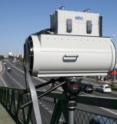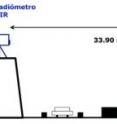New method for infrared remote sensing to analyze traffic pollution
The methodology, which has been used in this research in collaboration with the Universidad Europea de Madrid, is based on the Open-Path FTIR technique which takes advantage of specific properties of gases in order to detect them: they absorb radiation only in certain wave lengths which are always the same and particular to each gas. Many gases have absorption lines or bands in the infrared, for which this area of the electromagnetic spectrum is very useful for the remote detection of gases, according to the authors of this research from the UC3M Department of Physics. "With this technique all of the gases that have absorption bands in the infrared can be measured simultaneously, which are almost all of those that are of environmental interest: carbon monoxide, carbon dioxide, nitrogen oxides, ozone, methane, hydrocarbons, sulfur dioxide, chlorhydric acid, etc.", one of the researchers in charge of this study, Professor Antonio de Castro, pointed out. The object of their research is to experimentally determine the concentration of the chief gas pollutants associated with motor vehicle traffic. For that purpose, the researchers have developed a methodology that takes measurements outside of the concentration of different gases, mainly carbon monoxide and carbon dioxide. "This technique offers the advantages inherent to a non-intrusive measurement technique, avoiding having to take gas samples in special recipients and providing average concentrations during a measurement line defined in real time", this researcher from the UC3M Infrared Laboratory explained. In addition, the technique offers another important advantage: the capacity to simultaneously calculate the concentration of all the gases of interest taken from the same measurement.
Possible applications
This technique is highly valuable for resolving numerous environmental problems associated with atmospheric pollution, especially when the toxicity of the pollutants make simple in situ measurement dangerous, since it is not necessary to go into the polluted area to carry out the measurement. "The possibility of monitoring a wide spectrum of gases from a distance and observing wide areas in such a simple manner makes this technique a useful tool", the study's co-author, Professor Susana Briz asserted. She further pointed out that this technique allows, in addition to the measurement of the concentration of pollutants, the calculation of emissions associated with different environmental issues, such as the characterization and study of emissions associated with forest fires, green house effect gas emissions from dumps and agriculture installations, monitoring volcanic gases, etc. "You could say", Briz concluded, "that this technique is useful for almost all of the problems associated with atmospheric pollution and in general with the detection of gases".
To take a measurement it is necessary to have an infrared source, such as a very hot object, and a spectrometer, an instrument which analyzes infrared radiation that comes from the origin with its wave lengths, just as a prism does when it separates white light into the colors of the rainbow, the researchers explained. "If there is a certain gas between the infrared source and the spectrometer, its wave length characteristic is absorbed and that is detected by the instrument", Susana Briz explained. "Afterwards, the analysis programs are also capable of determining the concentration of that gas", she added.
At the moment, various field experiments in the towns of Villaviciosa de Odón and Leganés have been carried out to test the validity of the method to calculate emissions based on concentration measurements with the Open-Path FTIR technique, verifying the methodology with standardized equipment (extractives). The methodology proposed, based on dispersion models, has been proven in the opposite way: the emissions calculated independently (EMFAC2007) have been introduced, and the calculated concentrations have been compared with the experimental ones. "In light of these results, we can assert that the proposed methodology is an effective tool to experimentally estimate the emission factors associated with a certain way", the researchers concluded.



